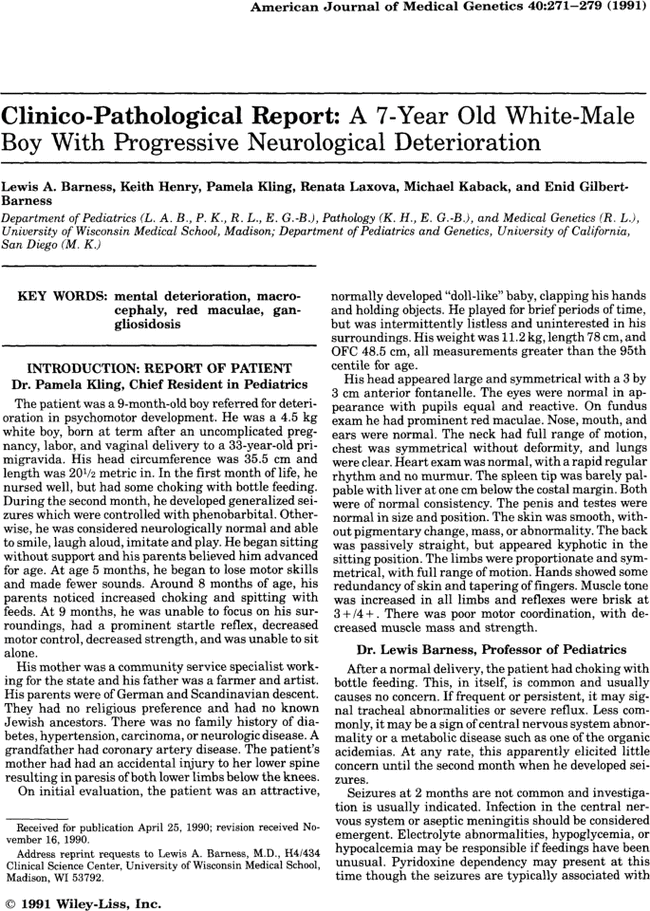Clinico-pathological report: A 7-year old white-male boy with progressive neurological deterioration
Corresponding Author
Lewis A. Barness M.D.
Department of Pediatrics, University of Wisconsin Medical School, Madison
H4/434 Clinical Science Center, University of Wisconsin Medical School, Madison, WI 53792Search for more papers by this authorKeith Henry
Department of Pathology, University of Wisconsin Medical School, Madison
Search for more papers by this authorPamela Kling
Department of Pediatrics, University of Wisconsin Medical School, Madison
Search for more papers by this authorRenata Laxova
Department of Pediatrics, University of Wisconsin Medical School, Madison
Department of Medical Genetics, University of Wisconsin Medical School, Madison
Search for more papers by this authorMichael Kaback
Department of Pediatrics and Genetics, University of California, San Diego
Search for more papers by this authorEnid Gilbert-Barness
Department of Pediatrics, University of Wisconsin Medical School, Madison
Department of Pathology, University of Wisconsin Medical School, Madison
Search for more papers by this authorCorresponding Author
Lewis A. Barness M.D.
Department of Pediatrics, University of Wisconsin Medical School, Madison
H4/434 Clinical Science Center, University of Wisconsin Medical School, Madison, WI 53792Search for more papers by this authorKeith Henry
Department of Pathology, University of Wisconsin Medical School, Madison
Search for more papers by this authorPamela Kling
Department of Pediatrics, University of Wisconsin Medical School, Madison
Search for more papers by this authorRenata Laxova
Department of Pediatrics, University of Wisconsin Medical School, Madison
Department of Medical Genetics, University of Wisconsin Medical School, Madison
Search for more papers by this authorMichael Kaback
Department of Pediatrics and Genetics, University of California, San Diego
Search for more papers by this authorEnid Gilbert-Barness
Department of Pediatrics, University of Wisconsin Medical School, Madison
Department of Pathology, University of Wisconsin Medical School, Madison
Search for more papers by this author
References
- Bolhuis PA, Oonk JG, Kamp PE, Ris AJ, Michalski JC, Overdijk B, Reuser AJ (1987): Ganglioside storage, hexosaminidase lability, and urinary oligosaccharides in adult Sandhoff's disease. Neurology 37: 75–81.
- Cantor RM, Lim JS, Roy C, Kaback MM (1985): Sandhoff disease heterozygote detection: A component of population screening for Tay-Sachs disease carriers I. Statistical methods. Am J Hum Genet 37: 912–921.
- Cantor RM, Roy C, Lim JS, Kaback MM (1987): Sandhoff disease heterozygote detection: A component of population screening for Tay Sachs disease carriers II. Sandhoff disease gene frequencies in American Jewish and non-Jewish populations. Am J Human Genet 41: 16–26.
- Chern CJ, Beutler E, Kuhl W, Gilbert F, Mellman WJ, Croce CM (1976): Characterization of heteropolymeric hexosaminidase A in human X mouse hybrid cells. Proc Natl Acad Sci USA 73: 3637–3640.
- Elwes R, Saunders M (1986): Generalized dystonia, whispering dysphonia and Wilson's disease in members of the same family (letter). J Neurol Neurosurg Psychiatry 49: 107.
- Hannun YA, Bell RM (1987): Lysosphingholipids inhibit protein kinase C: Implications for the sphingolipidoses. Science 235: 670.
- Inui K, Wenger DA, Furukawa M, Suehara N, Yutaka Y, Okada S, Tanizawa O, Yabuuchi H (1986): Prenatal diagnosis of GM2 gangliosidoses using a fluorogenic sulfated substrate. Clin Chim Acta 154: 145–150.
- Johnson W, Desnick R, Long D, Sharp M, Krivit W, Brady B, Brady RO (1973): Intravenous injection of purified hexosaminidase A into patients with Tay-Sachs disease. In D Bergsma, R Desnick, R Bernlohr, W Krivit (eds): “ Enzyme Therapy in Genetic Diseases.” New York: Alan R. Liss, Inc., p 120.
- Mattei JF, Balestrazzi P, Baeteman MA, Mattei MG (1984): De novo balanced translocation (5;13)(q11;p11) in a child with Franceschetti syndrome and significant decrease of hexosaminidase B (Abstract). Cytogenet Cell Genet 37: 532.
- Neuenhofer S, Conzelmann E, Schwarzmann G, Egge H, Sandhoff K (1986): Occurrence of lysognaglioside lyso-GM2 (II3-Neu-5-Ac-gangliotriaosylsphingosine) in GM2 gangliosidosis brain. Biol Chem Hoppe Seyler 367: 241.
- Rosengren B, Mansson JE, Svennerholm L (1987): Composition of gangliosides and neutral glycosphingolipids of brain in classical Tay-Sachs and Sandhoff disease: More lyso-GM2 in Sandhoff disease?. J Neurochem 49: 834–840.
- Schulte FJ (1984): Clinical course of GM2 gangliosidoses. A correlative attempt. Neuropediatrics [Suppl] 15: 66–70.
- Sandhoff K, Conzelmann E (1984): The biochemical basis of gangliosidoses. Neuropediatrics [Suppl] 15: 85–92.
- Sandhoff K, Andreae U, Jatzkewitz H (1968): Deficient hexosaminidase activity in an exceptional case of Tay-Sachs disease with additional storage of kidney globoside in visceral organs. Pathol Eur 3: 278.
- Sandhoff K, Conzelmann E, Neufeld EF, Kaback M, Suzuki K (1989): The GM2 gangliosidoses. In CR Scriver, AL Beaudet, WS Sly, D Valle (eds): “ The Metabolic Basis of Inherited Disease.” New York: McGraw-Hill, Vol. 72, pp. 1807–1839.
- Sonderfeld S, Conzelmann E. Schwarzmann G, Burg J, Hinrichs U, Sandhoff K (1985): Incorporation and metabolism of ganglioside GM2 gangliosidosis subjects. Eur J Biochem 149: 247.
-
Von Specht B,
Geiger B,
Arnon R,
Passwell J,
Keren G,
Goldman B,
Padeh B
(1979):
Enzyme replacement in Tay-Sachs disease.
Neurology
29:
858.
10.1212/WNL.29.6.848 Google Scholar
- Warner TG, De Kremar RD, Applegarth D, Mock AK (1986a): Diagnosis and characterization of GM2 gangliosidosis type II (Sandhoff disease) by analysis of the accumulating N-acetyl-glucosaminyl oligosaccharides with high performance liquid chromatography. Clin Chim Acta 154: 151–164.
- Warner TG, Turner MW, Toone JR, Applegarth D (1986b): Prenatal diagnosis of infantile GM2 gangliosidosis type II (Sandhoff disease) by detection of N-acetylglucosaminyl-oligosaccharides in amniotic fluid with high-performance liquid chromatography. Prenat Diagn 6: 393–400.




